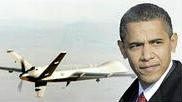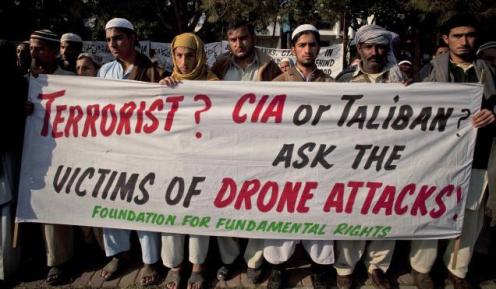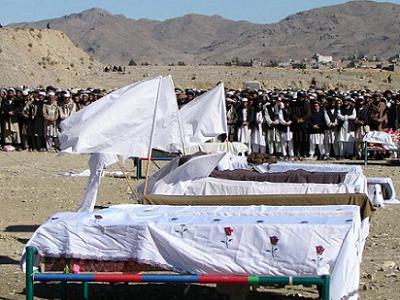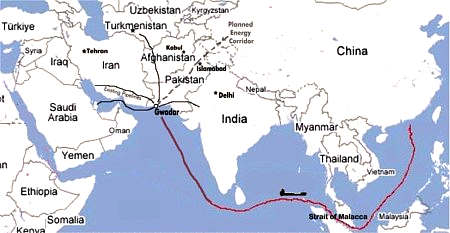February 2012 marks the fifteenth anniversary of the US Space Command’s declaration of war on the world, namely its quest to achieve Full Spectrum Dominance of land, sea, air and outer space by 2020, “to close the ever-widening gap between diminishing resources and increasing military commitments”1. Commenting on the Space Command’s announcement, Rebecca Johnson of the UN Disarmament Commission observed that,


“Notions of full spectrum dominance … are perceived as a security threat by countries that have no political desire or intention to threaten the United States, but which would be expected by their own citizens and militaries to develop countermeasures to deter the United States nevertheless”2.
One of the many dangerous aspects of Full Spectrum Dominance is the US Air Force’s Prompt Global Strike doctrine, which will give the United States “The capability to rapidly attack fleeting or emerging high-value targets without warning, anywhere on the globe,” in the words of the US Air Force (USAF)3. BAE Systems is developing the Taranis unmanned aerial vehicle (drone), which is being designed to “test the possibility of developing the first ever autonomous stealthy Unmanned Combat Air Vehicle (UCAV) that would ultimately be capable of precisely striking targets at long range, even in another continent,” the company boasted, indicating the drone’s potential for Prompt Global Strike4.
Following the exploitation of 9/11, the Pentagon and Whitehall have succeeded in securing two of the world’s major energy regions—the Middle East and Central Asia—and, under the pretext of a self-appointed Responsibility to Protect, are making means to control a third—North Africa (in lieu of the NATO assault on Libya). War planners envisage key energy areas, and eventually the world in general, patrolled by drones in order “to close the ever-widening gap.” In 2009, it was reported, erroneously, that US Defense Secretary Robert Gates had cancelled the $340 billion-dollar Future Combat Systems program, a Bush-era program designed to “build an entirely new army, reconfigured to perform the global policing mission”5.

It transpired that the system was not only going ahead (just the Unmanned Ground Vehicle component was being cut), but it was in fact being expanded. Renamed the Army’s Brigade Combat Team Modernization Initiative, the program actually involves the acquisition of more drones than previously anticipated, P.W. Singer noted in Wired For War, his generally enthusiastic study of robotic warfare. Furthermore, the principal contracts have been awarded to the Boeing corporation.

Col. Charles W. Manley on a training simulator March Air base in California manning an MQ-1 Predator Drone.
These, and other drones, are allowing USAF to be able to achieve its ultimate goal, “to find, fix, track, target, and engage any moving ground target anywhere on the surface of the Earth.”6
Civilian Deaths
|
|
|
Among the many Pakistan civiians killed |
Ever since a Boeing-co-produced Hellfire missile was launched from a Predator drone in 2002, the human cost of drones has been exponential7. “[A]long the mountainous eastern border of Afghanistan, a Predator reportedly followed and killed three suspicious Afghans, including a tall man in robes who was thought to be bin Laden. The victims turned out to be innocent villagers, gathering scrap metal,” the New Yorker reported. In November of that year, six people, each of them alleged to be suspected al-Qaeda militants, were also killed at the push of a button as they travelled through Yemen in a car8.
The US is currently running two drone operations: the military’s and the CIA’s. The latter is classified, and assassination orders come directly from the President. During George W. Bush’s tenure, the CIA conducted 45 known drone attacks. In the first year of Obama’s tenure, the CIA conducted 53 known drone attacks.

Drone assassinations extended to more countries
|
|
| A U.S. drone attack in Somalia killed 9 women and children and wounded 30 on Sept. 15 |
According to the Foreign Policy Journal, the CIA’s program “extends further [than the military’s], reaching countries such as Pakistan, Yemen and Somalia.” The drone strikes in Somalia, and elsewhere, “anger the population and make the Islamic insurgents more popular”9.
Drones used to kill U.S. Citizens
In its public letter to Obama, Human Rights Watch noted that, “The US government says 'the terrorist sympathizer,' Anwar al-Awlaki is linked to the Yemen-based al Qaeda in the Arabian Peninsula but has not brought formal charges against him,” concluding that targeting individuals for death without due process of law “will inevitably violate international law and set a dangerous precedent for abusive regimes around the globe.”10 Obama’s repeal of Executive Order 12333 has given the President the self-appointed right to assassinate US nationals (al-Awlaki) on the basis of their beliefs (however repugnant and provocative those beliefs may be).
Numbers of victims are under-reported
In 2009, Kathy Kelly reported that thirty schools in Afghanistan had closed because the children were too afraid of the drones to attend, and those who did could not concentrate.11 The Foreign Policy Journal reported that, “Since January 2008, more than 1,000 Predator sorties were flown out of Balad,” a US-occupied Air Base in Iraq, “lasting more than 20,000 hours.”12. The New York Times claimed that in 2007, the US launched 46 drone strikes in Iraq, 77 in 2008, and 6 in 2009. As the strikes apparently decreased in Iraq, they increased exponentially in Pakistan and Afghanistan13.
In January 2010, Bloomberg reported that the Pakistani government “said it doesn’t support U.S. drone attacks in its territory as they are counterproductive, after reports that raids … killed 17 [alleged, suspected] militants in a northwest region bordering Afghanistan.”14 In 2010, it was reported that since the start of drone operations in Pakistan in 2004, operators had killed 1,200 people. Of that number, 32% were civilians, according to an organisation which supports drone attacks, the New America Foundation.15
This would appear to be a gross underestimate when we consider that General Petraeus’s military advisor, Lt. Col. David Kilcullen, informed the New York Times that 714 people had been killed by drone operators in Pakistan in mid-2008 to mid-2009 alone, of whom 14 were “al-Qaeda” and/or Taliban suspects—meaning that 98% of the victims in that one period were civilians.16 Kilcullen’s figure is compounded by other factors present in the New America Foundation study.
In the first two months of 2010, at least 140 people had been killed in drone attacks. In that year, the US launched 118 strikes. According to Channel 4 News Online, the New America Foundation estimated that between 607 to 993 people had been killed by drone operators in 2010, and “the foundation [sic] suggests that only two per cent were senior Taliban or al-Qaeda figures,” a figure which corresponds to Kilcullen’s estimate for the previous year.17 In the Afghanistan-Pakistan region, “the number of attacks has increased from one per week to one per day,” the Foreign Policy Journal noted.18
On 17 March 2011, the Associated Press reported that “Pakistan’s army chief [Ashfaq Kayani] strongly condemned a US drone attack that killed more than three dozen people, saying the missiles struck a peaceful meeting of tribal elders near the Afghan border. … Kayani’s condemnation contradicted statements provided by Pakistani intelligence officials,” whom, the AP reported, had originally claimed that the “38 people killed and seven wounded in the attack were militants meeting to discuss sending additional fighters into Afghanistan”.19.
Nanotags - a new deadly technology

Drone attacks seem to be linked to a frightening new development in military/secret service assassinations: “nanotags,” or Radiofrequency Identification (RFID) chips. “I was given US$122 to drop chips wrapped in a cigarette paper at al-Qaeda and Taliban houses. If I was successful, I was told, I would be given thousands of dollars,” a young man from Wiziristan confessed to the Taliban before being shot for treason. “I thought this was a very easy job. The money was so good so I started throwing the chips all over. I knew people were dying because of what I was doing, but I needed the money.”20 The US historian and investigator, Gareth Porter, reported that “residents of Waziristan, including one student identified as Taj Muhammad Wazir, had confirmed that tribesman have been paid to lay the electronic devices to target drone strikes”.21
The New Yorker also reported “rumors that paid C.I.A. informants have been planting tiny silicon-chip homing devices for the drones in the tribal areas.”22 There are long-standing US military plans to “nanotag” everything.23
Britain’s Prince Harry exemplified the undying colonial-era racism of the UK establishment when he referred to one of his Army colleagues, Ahmed Raza Khan, as “our little Paki friend” — which was “just a joke”, of course.24 Contempt for people of another age, ethnicity, gender, nation, religion, etc., is a necessary part of the dehumanization process, which is itself necessary in order to attempt to justify the killing and torture of others—especially to oneself. When it comes to drones, however, there seems to be a new form of psychological distanciation between the action and the consequence. In 2009, the UN Rapporteur on Extrajudicial, Summary or Arbitrary Executions, Philip Alston, cautioned that operators risk developing “a Playstation [sic] mentality” to killing.25 Indeed, many drone and robot control panels are modelled on PlayStation and Xbox joypads.26
The Media Campaign
The grainy, monochrome, low-resolution images of buildings being vaporized seems to be part of the propaganda process of dissociation in the era of “clean wars.” The media rarely report who was in the given building, and when doing so usually cite unchallenged military allegations that the victims were “al-Qaeda” militants or Taliban fighters. This is not surprising. USAF’s forty-six year drone expansion plan stated in 2009 that the Air Force would seek to monopolize all of the information released to the media regarding drone attacks.
“In order to conduct a successful communication campaign, public affairs activities focus on three main areas of operation – Media Relations, Internal Information and Community Relations,” according to the detailed plan. “Additionally, communication strategies are executed at the senior levels of government by appropriate Air Force leadership to enhance leaders’ and lawmakers’ understanding of UAS [unmanned aerial systems’] current and future role.”27
The People Rise Up
“You’d be hard pressed to find a Pakistani anywhere in the world, regardless of class, education, or citizenship, who does not object to the U.S. drone strikes that have killed hundreds of innocent civilians in Pakistan since President Barack Obama took office,” Business Week reported, adding that “It would also be difficult to find a Pakistani who does not object to the government in Islamabad allowing the strikes to continue.”28
Liaquat Ali Khan reported in CounterPunch that, “In a case filed with the Pakistan Supreme Court,” a petition read: “The Americans, like in [former Pakistani President] Musharraf’s time, have also been given a free hand by President Zardari and fundamental rights of the (indigenous) people are being violated daily in tribal areas and (in northern areas of) Dir, Swat and Chitral. A large number of (indigenous) people have migrated from these areas and suffered tremendous losses with no hope of returning to their homes because of US drone attacks, but the government is sitting as a silent spectator.”

The people of Miranshah, the principal own in North Waziristan protesting by burning a U.S. flag in January, 1011
|
|
|
Pakistanis in the northern tribal areas thanked |
“Presuming that Pakistan is secretly supporting drone strikes,” Ali Khan continued, “the vengeful militants have begun to attack the citadel cities of Lahore and Islamabad. As drone attacks continue to kill and generate the IDPs [internally displaced persons] among the indigenous population and as militants undertake retaliatory measures in major cities, the nuclear-armed Pakistan is predicted to plunge into uncontrollable chaos and carnage threatening international peace and security.”29

In their analysis of the overall death toll in Pakistan from drone strikes between early- to mid-2009, BBC South Asia—tellingly, not BBC UK—highlighted the corollary between drone attacks and terrorist reprisals. Between 2009 and 2010, “nearly 2,500 people have been killed in Pakistan as a result of US drones and Islamic militant attacks. … Islamic militant strongholds in the border area close to Afghanistan have been targeted by US drone aircraft, while, at the same time, Islamic militants have carried out attacks across Pakistan.”
The BBC went on to explain how,
“Missile attacks by US drones in Pakistan’s tribal areas have more than trebled under the Obama administration … Compared with 25 drone strikes between January 2008 and January 2009, there were at least 87 such attacks between President Obama taking office on 20 January 2009 and the end of June 2010. More than 700 people have been killed in such attacks under Mr Obama, compared with slightly fewer than 200 from under his predecessor, George W Bush. The militant backlash over the same period has been even more violent. Extremists have struck more than 140 times in various Pakistani locations, killing more than 1,700 people and injuring hundreds more.”
Drones are Counterproductive to Imperial Objectives
The BBC concluded that “Pakistan has consistently argued that drone attacks are hindering rather than helping with the battle against extremism, saying they fuel public anger against the government and the US and boost support for militants.”30 The information on drone cause-and-effect in terms of how such civilian murders radicalize populations is very rarely reported by mainstream, Western television news networks, making Muslim terrorism (which is always reported) seem unprovoked.
Opposition to drone murders continues. More recently, Reuters reported “mounting resentment from Pakistanis who decry the government for bowing to U.S. wishes.”31 Perhaps in an effort to appease the mounting civilian opposition to drone attacks, President Zardari did acknowledge that “drones are radicalizing more people to side with the Taliban,” Arnaud de Borchgrave reported.32
In 2009, Pakistan’s Prime Minister, Yousuf Raza Gilani, “said missile strikes by US drones on the northwestern tribal areas bordering Afghanistan were in fact strengthening the militants,” the Financial Times (London) reported. Mehdi Hasan in the Guardian explained that Obama’s “backing of indiscriminate slaughter in Pakistan can only encourage new waves of militancy.”34 David Kilcullen recognized that “Every one of these dead non-combatants represents an alienated family, a new revenge feud, and more recruits for a militant movement that has grown exponentially even as drone strikes have increased.”35
Kathy Kelly reported in the Huffington Post that,

“The drones feed hourly intelligence information to U.S. war commanders, but the machinery can’t inform people about the spiraling anger as the U.S. conducts assassination operations in countries throughout the 1.3 billion-strong Muslim world.” Kelly cited Fred Branfman as saying that, “Sold as defending Americans … [it] is actually endangering us all. Those responsible for it, primarily General Petraeus, are recklessly seeking short-term tactical advantage while making an enormous long-term strategic error that could lead to countless American deaths in the years and decades to come.”36
Likewise, Le Monde Diplomatique confirmed that,
“The drones worsen the resentment of Pakistan’s people: Public opinion, which already views its government as corrupt, sees drones as an attack on the legitimacy of national power. While most of the world gives more credit to Obama than to his predecessor, his ratings in Pakistan are little higher than those of George Bush.”37
|
|
|
Pakistanis protest drone attacks in Karachi in 2010 |
Furthermore, the hometown of the failed Times Square bomber, Faisal Shahzad, “is close to the Pakistani region where the militants are now being targeted by U.S. drone attacks,” Business Week reported. The terrorism specialist Jerrold Post was quoted as saying, “There is intense anti-American sentiment in Pakistan. This has been magnified by some of the drone killings, [and] targeted assassination[s].” Business Week added that,
“Shahzad felt let down when his home government failed to put a stop to the drone strikes carried out by the government of his host country. He seems to have experienced some sort of psychological break[down], after which he was no longer defined by family and career, but by what he felt was the failed policy of both countries.”38
“Anti-US sentiment deepened markedly in Pakistan in 2009 due to perceived US violations of Pakistani sovereignty through aerial drone strikes in the tribal areas that killed hundreds of civilians,”
Human Rights Watch noted in its annual global report, “and persistent rumors, denied by Pakistani authorities, that personnel from the private military company Xe Services ([formerly] Blackwater) are conducting covert operations in Pakistan,” concluding that “Substantial sections of Pakistani society, particularly opinion makers and the media, blamed US behavior for the surge in militant attacks in the country, even as they expressed broad support for the government’s fight against the Taliban and affiliated groups.”39
Drone resistance is proving difficult, with “a Pakistani court up[holding] the dismissal of a petition against US drone attacks,” The Jurist reported in 200940. Added to which, Kathy Kelly and three friends, were arrested in the United States for trespassing, “when after a ten-day vigil outside the [Creech] air force base, we entered it with a letter we wanted to circulate among the base personnel, describing our opposition to a massive targeted assassination program.”41

Kathy Kelly and fellow protestors arrested at Creech Air Base. Kathy and dozens of others were arrested again in April, 2011 at the at the Hancock Airbase in Syracuse for protesting drones.
Le Monde Diplomatique highlighted the “economic reality” of murdering people with robots. “It costs $2.6m to train a US fighter pilot and just $135,000 to train a drone pilot.” Micah Zenko, of the Council on Foreign Relations, was quoted as saying that in 2008, “the Bush administration took the decision to turn the CIA into a counter-insurrection air force working in support of the Pakistani government … The CIA attacks are secret, which rules out a public debate on their effectiveness.”42

Pakistan-China Gas-Oil Pipeline
|
|
|
The pipeline across Pakistan for delivering |
There is something familiar to intelligence analysts which does not seem to penetrate much mainstream or even antiwar analysis, namely that a destabilized Pakistan is in the Pentagon’s interest because of its destabilizing effect on China. A National Intelligence Council Study pointed out in 2008 that were Pakistan to “erupt,” it would hamper the Sino-Iranian oil and gas ambition to construct a pipeline through Pakistan in order to supply China with cheap Iranian resources (China already having taken a loss on Iraqi oil due to the Anglo-American occupation, the Iraqis having taken an incomparably worse loss). “China’s concerns about security in Pakistan … have dampened plans for a Pakistan-China oil pipeline,” the NIC affirmed. Out 2025, the NIC predicted in a futures study, “the long-delayed plans for the “peace pipeline” connecting Iran, Pakistan, and India (IPI) are back on track again, and the IPI pipeline may be extended to China,” hence the need to destabilize Pakistan. The only feasible routes for the pipeline are through Afghanistan and Pakistan—one of which is under an Anglo-American occupation, and the other is being subjected to mounting drone attacks.43
Robot Ethics Put People 'Out of the Loop'
These “chessboard” games, as British colonialists used to refer to the ruining of people’s lives, have an extra, potentially terminal potency in today’s nuclear weapons-armed world—as Liaquat Ali Khan, and others, have pointed out. As trade barriers are lowered for nanotech, and other highly dangerous technologies, the human race is pushed to what Martin Rees, one of the world’s leading astrophysicists, cautioned in his book Our Final Hour?, namely humanity’s “fifty-fifty” odds of surviving the next ninety years “without a serious setback.”
A few years after Rees’s warning, a US Navy-commissioned study into robot ethics noted parenthetically that “civilian computer systems have failed and raised worries that can carry over to military applications … Thus, it is a concern that we also may not be able to halt some (potentially-fatal) chain of events caused by autonomous military systems that process information and can act at speeds incomprehensible to us, e.g., with high-speed unmanned aerial vehicles.”44 Likewise, the UK Ministry of Defence, a couple of years later, predicted that out to 2040, “the increased complexity of networks are likely to increase the risk, and the impact of catastrophic systems failure [emphasis in original].”45.

A Drone Operator uses a nintendo-style joystick, directing his deadly payloads across to Waziristan in the north-western territories of Pakistan from the comfort of his armchair at Creech Air Base in Nevada.
These highly dangerous systems are due to become even more hazardous as human beings are put “out of the loop,” to use the military parlance, by autonomous systems. According to USAF’s drone expansion plan, “Increasingly humans will no longer be “in the loop“ but rather “on the loop” – monitoring the execution of certain decisions.”46 However, the US Navy-commissioned study noted that, “One of the few near-certainties in the development of military robots is that keeping a human in the decision-making loop is going to seriously degrade battle efficiency,” meaning that safety is an institutional flaw of the military.47
Dangers of New Technologies for Humanity
Humanity’s greatest challenges were perhaps best laid out in a futures study by the UK Ministry of Defence, published a few years prior to the one cited above. “Many of the concerns over the development of new technologies lie in their safety,” the MoD acknowledged, “including the potential for disastrous outcomes, planned and unplanned.” We may wish to take note of the word planned.
“For example, it is argued that nanotechnology could have detrimental impacts on the environment, genetic modification could spiral out of control and that AI [artificial intelligence] could be superior to that of humans, but without the restraining effect of human social conditioning.”
The MoD concluded that “Various doomsday scenarios arising in relation to these and other areas of development present the possibility of catastrophic impacts, ultimately including the end of the world, or at least of humanity”48.
Notes
- US Space Command, “Vision for 2020”, February, 1997, Col.: Petersen Air Force Base.
- Rebecca Johnson, “Security without weapons in space: challenges and options”, United Nations Disarmament Commission, No 3., 2003, pp. 55-6.
- Cited in Vince Manzo, 2008, An Examination of the Pentagon’s Prompt Global Strike Program: Rationale, Implementation, and Risks, Center for Defense Information.
- BAE Systems, “Taranis Combat Aircraft Thunders into view”, news release, 12 July, 2010, Ref. 137/2010.
- Defense Department cited in Jack A. Smith, “The Next War, and the Next”, Asia Times, 10 March, 2007,
- United States Air Force cited in Van Atta, R.H., Cook, A., Gutmanis, I., Lippitz, M.J., Lupo, J., Mahoney, R. and J. H. Nunn, “Transformation and Transition: DARPA’s Role in Fostering an Emerging Revolution in Military Affairs Volume 2 – Detailed Assessments”, Institute for Defense Analyses, November, 2003, Virginia: IDA.
- On Boeing’s role in Hellfire manufacture, see Amnesty International, “Operation ‘Cast Lead’: 22 Days of Death and Destruction”, July, 2009, London: Amnesty, pp. 111-2, n60.
- Jane Mayer, “The Predator War”, The New Yorker, 26 October, 2009.
- Aleksandra Bielska, “Drone Attacks – The Proliferation Of A New Form Of Warfare”, Foreign Policy Journal, 27 August, 2010.
- Human Rights Watch, “US: Clarify Position on Targeted Killings”, 7 December, 2010.
- Kathy Kelly, “The Indefensible Drones: A Ground Zero Reflection”, Huffington Post, 8 September , 2010.
- Bielska, “Drone Attacks…”
- Christopher Drew, “Drones Are Playing a Growing Role in Afghanistan”, New York Times, 19 February, 2010.
- Khalid Qayum, “Pakistan Criticizes U.S. Drone Attacks After Raids Kill 17”, Bloomberg, 7 January, 2010.
- Dean Nelson, “One in three killed by US drones in Pakistan is a civilian, report claims”, Telegraph, 4 March, 2010.
- David Kilcullen and Andrew M. Exum, “Death From Above, Outrage Down Below,” New York Times, 17 May, 2009.
- Channel Four News Online, “US drone attacks ‘failing to kill many militant leaders’”, 21 February, 2011.
- Bielska, “Drone Attacks…”
- Associated Press, “Pakistan army chief condemns drone attack that killed 38 people”, Guardian, 17 March, 2011.
- Gareth Porter, “US drone attacks cloaked in secrecy”, Asia Times, 17 June, 2009.
- Ibid.
- Mayer, “The Predator War…”
- Dennis M. Bushnell, “Future Strategic Issues/Future Warfare [Circa 2025]”, NASA Langley Research Center, undated, archived by the Federation of American Scientists.
- Associated Press, “Muslims, Brits criticize Prince over comments”, MSNBC online, 11 January, 2009.
- Alston quoted in Bielska, “Drone Attacks…”
- P.W. Singer, Wired For War, London: Penguin, 2009.
- US Air Force, “Unmanned Aircraft Systems Flight Plan 2009-2047”, 18 May, 2009, Washington, DC: USAF Headquarters.
- Maha Hosain Aziz, “Pakistan, Terrorists, and Economic Stress”, Business Week, 8 June, 2010.
- Liaquat Ali Khan, “Drone Attacks on Pakistan’s Indigenous Tribes”, CounterPunch, 20 April, 2009.
- BBC News South Asia Online, “Mapping US drone and Islamic militant attacks in Pakistan”.
- Saud Mehsud, “First U.S. drone attack in Pakistan in weeks kills 7”, Reuters, 21 February, 2011.
- Arnaud de Borchgrave, “America’s Billion Dollar Intelligence Boondoggle”, Atlantic Council, 12 January, 2010.
- Farhan Bokhari, “Pakistan urges US to stop drone attacks”, Financial Times, 24 May, 2009.
- Mehdi Hasan, “US drone attacks are no laughing matter, Mr Obama”, Guardian, 28 December, 2010.
- Kilcullen quoted in Jane Mayer, “The Predator War…”
- Kelly, “Indefensible Drones …”
- Laurent Checola and Edouard Pflimlin, “Drones command the skies”, Le Monde Diplomatique, December, 2009.
- Maha Hosain Aziz, “Pakistan, Terrorists, and Economic Stress…”
- Human Rights Watch, “Pakistan: Country Summary”, Annual Global Human Rights Report 2009, January, 2010, NY: HRW.
- Amelia Mathias, “UN rights investigator warns US drone attacks may violate international law”, The Jurist: Legal News and Research, 28 October 28, 2009.
- Kelly, “Indefensible Drones…”
- Checola and Pflimlin, “Drones command the skies…”
- National Intelligence Council, “Global Scenarios to 2025”, November, 2008, pp. 20-1.
- Lin, P., Bekey, G. and K. Abney, “Autonomous Military Robotics: Risk, Ethics, and Design”, 20 December, 2008, San Luis Obispo: Ethics and Emerging Sciences Group.
- Ministry of Defence (UK), “Strategic Trends Programme: Out to 2040”, 9 February, 2010 (4th ed.), London: MoD.
- USAF, “Unmanned Aircraft Systems Flight Plan 2009-2047.”
- Lin et al., “Autonomous Military Robotics.”
- Ministry of Defence (UK), “The DCDC Global Strategic Trends Programme 2007-2036”, Ministry of Defence, 23 January, 2007 (3rd), London: MoD.




